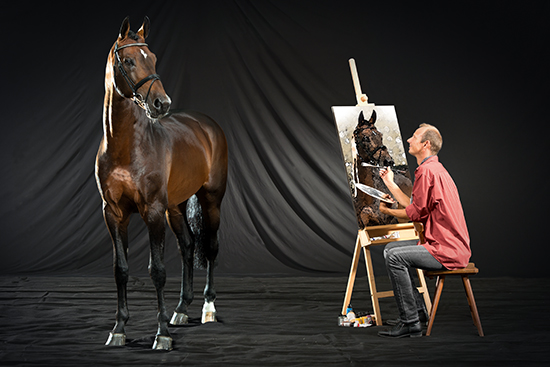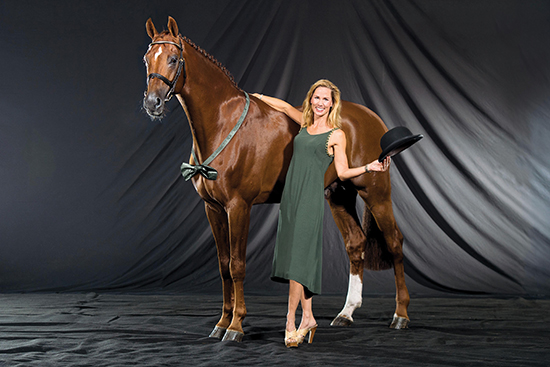Eva Bitter and Marco Kutscher
Story by Christopher Hector & Photos by Roz Neave.
Glamour shots by Kiki Beelitz
I’d met Eva Bitter first at Spangenburg Show, and interviewed her about the great stallion that shared so much of her showjumping life, Stakkato. So I knew that she was intelligent and articulate, an interviewer’s dream. She is also pretty much a photographer’s dream. At that stage, international superstar jumping rider, Marco Kutscher had just left his long term home at Ludger Beerbaum’s stables, to set up a home with Eva at her training stables at Bad Essen – so I figured Marco had to be a pretty special guy, but I hadn’t counted on him being quite so open, talky, and funny.
There’s no chance of losing your way to Argleth stables, as you get near, a huge chimney stack looms on the horizon, spelling out ARGLETH – it’s Eva’s family’s business, a huge factory producing industrial tiles, and tacked on down the end are the stables. They are horsemen’s stables, not gold plated or oak paneled, functional stables, the sort where real horsemanship thrives.
The new partnership had involved a little re-arranging, Eva explains, “Marco has more horses than me, so he moved in down this end, while my horses are down the other.”
That move was easy enough, but when Marco brought his own head groom from Ludger’s, it was not quite so simple. Marco’s groom had very firm views on how horses were to be fed, stabled and cared for, and Eva had very firm views on how horses to were to be fed, stabled and cared for.
“I felt like it was not my own home…” Something had to give. Marco’s groom left and a new crew of stable staff from Sweden and Finland were installed, and the stables run on Eva’s recipe of lots of time outdoors, and lots of riding through the forest behind the two beautiful old fashioned Oldenburg houses that are home to Eva’s father and Marco and Eva.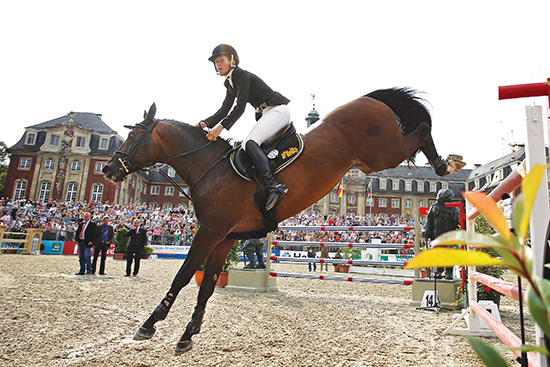
Stakkato has been with Eva from a four-year-old / Photo: Jacques Toffi
“Now Marco is also happy with it, he thought that I would end his life, wreck his career – and now he sees you can do it a little bit different and the horses look good, jump good. I have always thought that the horses should be… happy sounds so stupid that word, but they should like to do what they have to do at the weekend. You can’t just do hard work every day, you need to go into the forest as well, and then it is easier for them to do these big things they do for us – travelling for twelve hours, jumping in three classes…”
“When we ride the horses out it is good training for them, uphill, downhill. In the beginning it is tough for them, they are breathing hard when they get to the top of the hill, but when they have done it a few times, you really see a difference in their muscles. Now all the horses go out – I wouldn’t say they jump higher or win more Grand Prix. For example at Ludger Beerbaum’s stables, they don’t have a forest and there are no hills, and the horses win so much. I think you can keep horses in stables all the time, and work them every day hard and they take so much that they still go out and win – but we have a responsibility, we can take a lot from them, but you should also give.”
“The horses wouldn’t say, oh put me on the truck I would like to go to the big horse show at Valkenswaard, but we do the sport and that’s why we have the responsibility to be fair to the horse – so they know, oh now I get food always at the same time, now I go into the field, now we will have the normal work, I always do it like that with my horses.”
“It’s the same with my stallions – they know completely, now it’s riding, now it’s breeding time, they are completely quiet. Sometimes on the transport, they stand next to a mare, and there is no problem with that. I think this also comes from my system, they know we never ask them something that is really unfair or more than they can do. They are satisfied…”
“I only work here in the mornings, until lunchtime, then in the afternoon I go into the office. I am a little bit involved in my dad’s company and I try to manage all the office things here from the stables. It is quite a lot.”
“I was in Ludger Beerbaum’s stables for two years, training with him. It was a super possibility for me – I learnt a lot, how to be more professional, and also with the riding. I was lucky that I had a very nice mare, Luna Luna, at this time. Ludger changed the bridle of the horse, I rode her with a hackamore and this was a huge difference. I had much better control and it was much easier for me to be able to ride the horse. In a very short time I came from 1.40 level to Nations Cup at St Gallan, Le Baule and Hickstead. This was very special.”
“Luna Luna was not the soundest horse and when she was 13 she was basically out of the sport. Then I had Stakkato who was four years old. Stakkato was the first young horse in my career. I always had old horses before that had learned all the stuff from other people and I learned from those horses. Now I had to teach a horse. I was again really lucky because the horse was Stakkato, and Ludger was helping me. I am really grateful for my time at Ludger’s.”
When we visited Ludger, it looked like a dressage stable – no one was jumping the jumps, they were all doing beautiful flat work…
“Absolutely. That’s what it is all about, the dressage work, and that is my system. Okay there is someone like Gert-Jan Bruggink, he can go over a course with a horse that doesn’t know anything about dressage, and it looks like he has no control, it is a completely different system. For me, personally, I couldn’t do a 1.10m course with a horse like this. I need the control. I like to do the dressage work.”
“We are still training with Manni Kötter, the really old guy – he went to Sydney to the Olympics, and to Atlanta, he was riding the German team horses there and helping them. Every Monday morning, he comes here. He wakes you up: WHAT ARE YOU DOING? You can win a €100,000 Grand Prix like Marco did at Valkenswaard, and when you train with Manni the next day, you come back to earth very quickly.”
Eva, Marco and Manni
“He’s not often at the shows, and he was never like an official trainer. He is not really educated, what he says, you might not find written in a magazine or a book, but he can do things with horses that are amazing. Sometimes he will tell you something like, come now with the left leg, and you think, Hey? Why this? And you do it, and you feel a big difference in the horse, and it goes much better.”
“I read about stuff like Rolkur, and so many theoretical things… Manni doesn’t even think about these things. Sometimes for example Manni will put a draw rein on a horse, and it is really right behind the vertical and you think what is this? But he first gets the horse from behind, and it comes up and up, half an hour of really hard work, and the horse goes like it should be. Other people would say, no, you cannot do this, you will make it too short in the neck, but Manni always says when they are behind the bit, you have to hold them, and get them quicker from behind, and it is hard to explain, but after 20 minutes the horse is on the bit, and the neck is long, and it is how it should be. He doesn’t read any of those articles, he doesn’t listen to any of the discussion, he just knows how it should be. Sometimes if he can’t explain it or we can’t do it, he sits on the horse and shows you, and after five minutes it is a really big difference.”
“He was a competition rider, but not so successful because he always showed the really difficult horses, and it is still like that. He doesn’t like horses like Van Gogh, because they are so easy, Manni likes the complicated horses that need a lot of work, and it was like that during his career he always had problem horses. Still he placed at Aachen, he was placed a few times in the Hamburg Derby and in the top ten at the German championships, but still he was not like an international superstar.”
“He is a great trainer, it is old fashioned but I think the whole system is old fashioned, the horses are the same, more or less, it is an old story. When I see the dressage pictures from earlier times, okay it looks a bit different, the horses are not so pretty, but you see the poll is the highest point, and the nose is just in front of the vertical – now you look at some of the modern pictures, and it is not so nice.”
Working with Marco full-time, has that changed your riding?
“I can learn from him every day, sometimes it is a little bit frustrating when you see him doing things – it just comes naturally to him, he didn’t learn it – sure he has learned a lot, but he just does it. Everything is so natural for him, and there are so many things that I have to try hard to do well. Watching him every day, I try to get better.”
Marco had finished working his horses and joined us for coffee. Like Eva, his conversation bubbles over into laughter, you get the feeling that he too is still thinking about the staff change-over at Argelith:
“Now I have been working in equestrian sport for over 20 years, with grooms and everything and all the logistics, and in those years there have times when things were really nice, but also times when it wasn’t – then you have to take a decision, even if it is hard, because life is too short. You have decide where are the important things – but like Eva said, things are on a good way now.”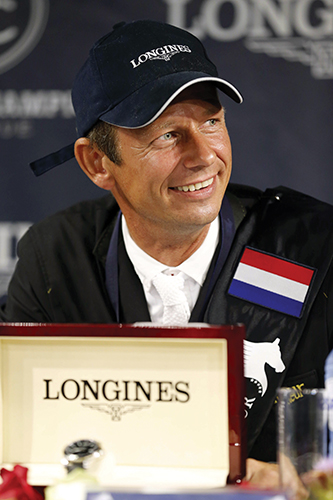
Were you born into a riding family?
“No. Not at all. More family had nothing to do with horses. When my brother and I were little boys, my parents were looking for something to do when they were not working, and they started with lessons in a riding club. They took us to the riding club, and while they were getting lessons, we were vaulting, or riding ponies, or whatever. We really started from nothing and then it became more and more. We had a normal one family house, but we could rent the field behind our house, two hectares, and we built first one stable, then a second, in the end we had three or four boxes at home.”
“When I was sixteen I left school to become a professional rider. I went to a big dealing stable, it was big in the area, but not an international sport stable. I really enjoyed that time, I rode 10, 15 horses every day, went to shows every weekend with ten horses. I learned a lot in that time – I stayed there for five-and-a-half years.”
“In 1997, that was the year when I had to go into the army for a year, and you have the choice in Germany, if you are good in your sport, you can do a basic four weeks in the army, and then you are based in Warendorf at the Olympic Training Centre with horses and you can do your national service there.”
“I had been in touch with Ludger and when he was looking for another rider at the end of ’99, he asked me to join him, at that time I was working by myself. It was not the worst decision of my life!”
How did he influence the way you ride and train?
“At the time I joined him, I had done a lot with young horses. I was 24 at the time, so I was made as a rider but for sure Ludger taught me a lot, especially on the higher level. It was fifteen years, and a very nice time.”
“I was really lucky when I came to Ludger – at that time he had seven or eight top Grand Prix horses. He was winning every weekend, or coming second to Franke Sloothaak, he was unbelievably successful in that time. I got some of the older horses, like PS Priamos, old but really good and successful. Normally that wasn’t the plan that I should go to international shows, when I started with Ludger he wanted to use me as the rider of young horses and to go to local shows, or the Bundeschampionate, to educate his young horses. But it turned out different, I was really lucky. Already in the first year I was allowed to go to a Nations Cup show…”
(That was on Priamos, who had already been to two WEGs, Rome with Ludger and The Hague with Dirk Hafemeister, as well as four World Cup finals with the pair)
“Then Montender came, Ludger had so many older horses, he didn’t have time to ride a seven or eight year old horse, so I got Montender – actually he was ridden by my brother before, all really lucky circumstances which made me what I am now. Then so many good horses, Cash, Controe, Cornet Obolenksy, each of them world class horses, sometimes at the same time, sometimes in a row.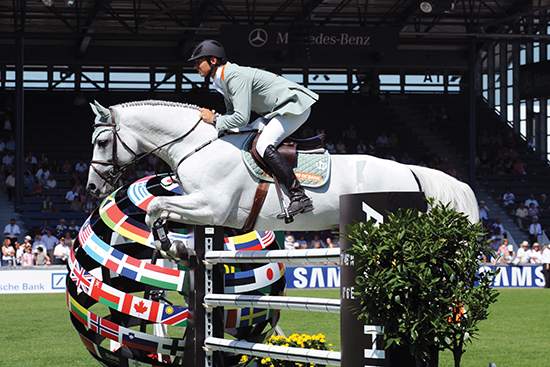
Marco and Cornet Obolensky
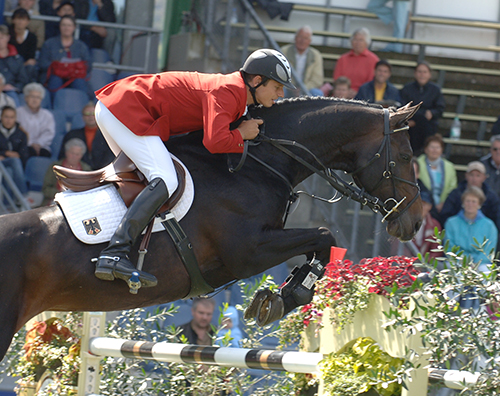
Marco and Montender at Aachen
(Marco is not exaggerating, by 2003 he was featuring in Germany’s Nations Cup team with Montender, in 2007 he rode Cornet Obolensky in the winning team at the Nations Cup Final in Barcelona, and won his first international Grand Prix with Cash at Vigo. Cash went on to win Grand Prix in Paris, Oslo and Turin. Marco was selected for two Games, Athens with Montender, Beijing with Cornet Obolensky, and rode in five World Cup finals, two with Cornet, three with Cash.)
Was Cornet Obolensky very special?
“He was special, special to ride, he has a special character…”
Not easy…
“No, no, no, he wasn’t easy – he didn’t always follow what I asked.”
At this point Marco and Eva burst into laughter…
“I had some really nice memories with Cornet, but also some not-so-nice ones. He was four when I started riding him…”
Tell him about the first show, Eva chimes in, luckily for me…
“I took him to a real show when he was five. I remember it exactly, in May, the first outdoor show. Cornet was special, at home he was lazy, not even like a stallion, but when you took him off the truck somewhere else, he was like a lion. He was going on two legs, crazy, screaming, wild, not under control, nothing – he forgot everything you taught him at home. At home, you almost had to kick him to go.
“The first show, I took my best groom with me, I put the truck in the corner where it was quiet, all the time I was thinking what can go wrong? So we took him down from the truck and I told my groom, when I have my foot in the stirrup, just let him go. You cannot hold a stallion when you want to get on them, if they can move, it is always better. (Marco is laughing at the memory) When I lifted my leg up, he was already going on two legs, but I had my foot in the stirrup, so my groom did what I told him to do, he let go. Cornet went ten metres on two legs, I was hanging around his neck, but then there was a fence for sheep, very low, he was on two legs, his eyes were in the sky, he didn’t see the wire, he came down with his legs in front of the wire, and tipped over, I flew left, Cornet flew to the right.”
“I remember it as if it was yesterday. At the time, the horse was already famous, he was one of the best approved stallions of the licensing, everybody was talking about him, he bred four or five hundred mares when he was two-and-a-half, and he was owned by this Ukranian guy, when I turned around and saw this white stallion getting up and galloping past me, jump over the next wire – into a field, away from all the horses, away from the truck. Normally horses go back to the truck, or as a stallion they try to go to other horses… no he jumped, just one wire, one metre forty, it was hard for me to see the wire but he jumped two metres twenty up and five metres wide into the field, just ploughed and so deep, his tail up and he was gone like a balloon when you stick a pin in it. Whooosh!”
“I was thinking, okay now Kutscher you have a problem, this horse might be dead after this, or the tendons bowed, break his legs, and you see this Ukranian guy with a Kalashnikov wanting to kill you because I have ruined this stallion of the century.”
“We were lucky because there was a field one kilometre away with other horses. He galloped there, and walked around trying to get into the field, we caught him, lunged him again, then I got on, jumped the class, he won, then there was another class which was the qualifier for the Bundeschampionate, and this he needed. As a Belgian horse he was not allowed to go to the Bundeschampionate, but as a stallion they have to jump in a Bundeschampionate qualifier and get more than 8 for their stallion approval to be allowed to breed. This was the main class, the second one. So I stayed on him because I was afraid to get off, stayed on for one and a half hours, jumped the second class, he had one down but still got the points because he was still jumping amazing. Then I put him in the truck.”
“For a long time when you went to shows and got on him, for the first five minutes he was always a little bit tense, then he was okay. When he got older, he was nice.”
Have you ridden many of his progeny – are they like him?
“Some of them yes, but they are all different. Most of the Cornet offspring, they can all jump. They are sometimes a bit special, others are really easy and nice to ride, some not, but I think you have that with any stallion.”
What are your goals now? Do you look to Rio?
“Yes – but not as a rider.” It’s laughs time again. “I think at the moment there is not a real chance to get into the team for Rio. But then I didn’t expect Van Gogh to win a Global Champions Tour Grand Prix, maybe during the winter he will progress, and maybe there is a chance with him. But when I see our team at the moment, with our riders and horses, you would have to fight to get into it, and I don’t really see a chance.”
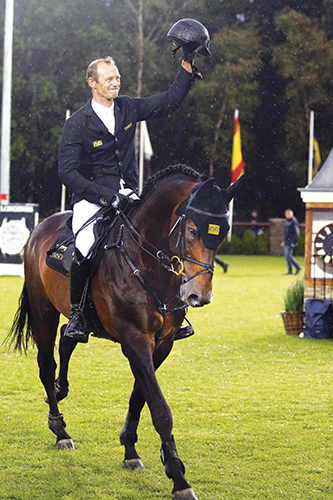 Did you get Van Gogh as a young horse?“No, I got him last year, when I left Ludger’s place. I have known the owners for a long time, and I rode the father, Numero Uno.”
Did you get Van Gogh as a young horse?“No, I got him last year, when I left Ludger’s place. I have known the owners for a long time, and I rode the father, Numero Uno.”
“Numero Uno was super nice, he was also a very pretty horse, super nice in the flat work. Maybe he didn’t have the biggest scope, but he was winning 1.45 / 1.50 and now he is very successful as a breeding stallion.”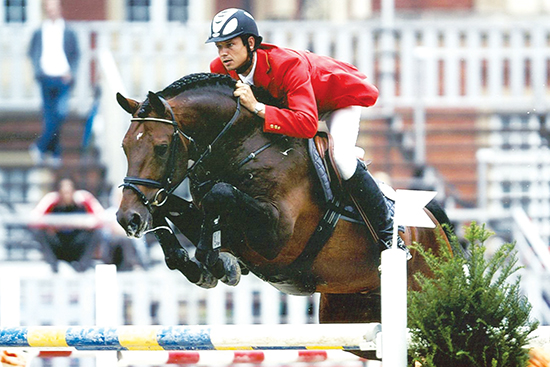
Marco and Numero Uno
“Van Gogh is a little bit more scopey than his father, but also a little bit more slow. Numero Uno was also one for speed classes. Van Gogh has become faster in the last few months, but he is not as quick as Numero Uno was. But he is scopier, and you can’t have everything. I am lucky that I have him. He is a stallion and you have to watch out for that, always a bit naughty, he wants to attack you, but in a fun way. You know what he is doing, so he is not dangerous and he is super nice to ride.”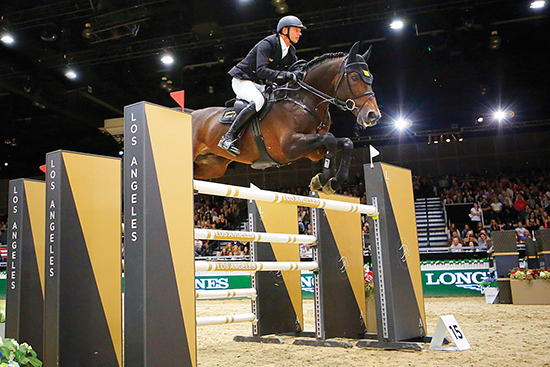
Marco and Van Gogh, victory in the Grand Prix at the Longines Masters of Los Angeles / Photo: McCool Photos for EEM
He looks like he has the paces to be a dressage horse…
“He can do all the things they ask in Grand Prix – piaffe, passage, one time flying changes. I can’t do these things, but he can do these things with Manni. He is a very nice horse. I’m lucky because at the moment my two other horses, Cornet’s Cristallo and Liberty are out of action, so we try to go on and be successful. Try to keep the standard, which is very hard… and if not? Life goes on.”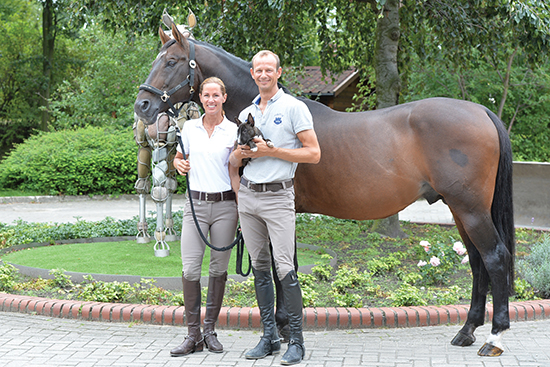
Life does go on. We take a ‘family’ shot, Stakkato and Eva, Marco and Eva’s miniature bull terrier, and as we do, a couple of the riders head off up the hill, “see the horses,” Eva cries, “See their muscles, they don’t look too bad do they?”
You’re right, Eva, things are looking great.


